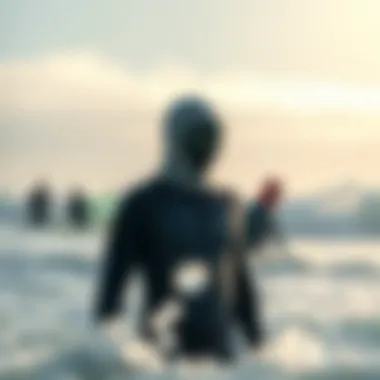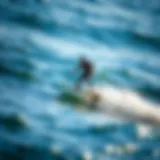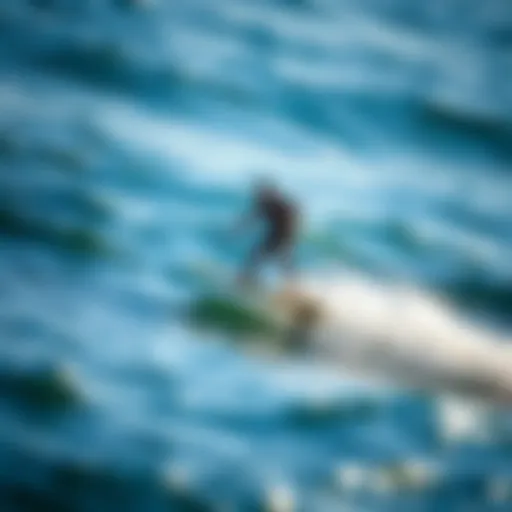Choosing the Best Winter Wetsuit for Kiteboarding


Intro
When winter rolls around, many kiteboarding enthusiasts face the challenge of balancing performance with the necessity of warmth. Cold waters can quickly turn a thrilling ride into an uncomfortable experience, making the right wetsuit more than just a piece of equipment—but rather an essential element for enjoyment and safety. This guide aims to explore critical factors in selecting the perfect winter wetsuit for kiteboarding, touching on materials, thicknesses, and innovative technologies available in today’s market. By ensuring that both novice and seasoned kiteboarders make well-informed decisions, this article serves to elevate your winter watersport experience.
Techniques for Kiteboarding Enthusiasts
Beginner Techniques
For those new to kiteboarding, acquiring fundamental skills is crucial. Learning to control the kite effectively, perform simple maneuvers, and understand the wind dynamics will help build a solid foundation. Start with easy moves, such as the water start or the basic upwind run. Understanding how to keep balance while navigating through the water is key. As you progress, gradually incorporate small jumps or turns to your repertoire, all while making sure you have the right thermal protection that enhances comfort even during chilly winter outings.
Advanced Maneuvers
Once you’ve solidified your base skills, you might want to venture into more complex techniques. Advanced kiteboarders often focus on high jumps, flips, or tricks like the kite loop. Mastery of these moves not only requires physically demanding control but also a thorough understanding of how your wetsuit can support mobility. A well-fitting wetsuit that allows for extensive movement will make a significant difference. Additionally, choosing one equipped with a thermal lining can help maintain body heat, which is vital when trying to push your limits in cold waters.
"A well-chosen wetsuit isn’t merely supplementary gear; it’s part of the kiteboarding experience, especially when winter chills set in."
Equipment Reviews
Wetsuit Materials and Thicknesses
Choosing the right material is fundamental when selecting a winter wetsuit. Neoprene is the industry standard, with varying thicknesses suitable for different temperatures. For instance, thicker materials, such as 5mm or 6mm, are appropriate for colder climates, while 3mm suits might suffice in milder conditions.
- Nylon-coated neoprene: Offers durability and comfort.
- Limestone neoprene: Provides flexibility and warmth.
- Chambered wetsuits: Use air pockets for insulation and buoyancy.
When shopping for a suit, don’t overlook additional features such as sealed seams, which minimize water leakage, and thermal linings, which retain body warmth more effectively. A combination of factors from material choice to seam construction can greatly affect your overall performance and comfort level.
Leading Brands on the Market
Among the top manufacturers, O’Neill, Mystic, and Rip Curl stand out for their quality and innovative designs. O’Neill's Psycho series is particularly noted for its flexibility and thermal properties, making it ideal for kiteboarding enthusiasts facing chilly winds. Mystic’s wetsuits often incorporate 4-way stretch materials and quick-dry linings. Rip Curl is well-known for its Dawn Patrol models, catering to a range of skill levels and thermal needs. Each of these brands has earned a reputation based on customer satisfaction and product performance in harsh conditions.
For further information about kiteboarding techniques and equipment, consider checking resources like Britannica or Reddit.
Remember to keep your skills sharp and your gear optimal for an enjoyable winter on the water!
Preamble to Winter Wetsuits
As kiteboarding enthusiasts eagerly anticipate the winter season, selecting an optimal wetsuit becomes vital for ensuring both comfort and performance. A well-fitted and thoughtfully designed wetsuit not only provides insulation against frigid water temperatures but also enhances mobility during the ride. In this introductory section, we will explore the significant factors that underscore the importance of a quality wetsuit and give an overview of what winter kiteboarding entails.
Importance of a Quality Wetsuit
When the temperature dips and the winds pick up, the right winter wetsuit can make or break a kiteboarding experience. A quality wetsuit serves multiple purposes: it acts as a thermal barrier, reduces the risk of hypothermia, and allows for full range of motion essential for executing tricks and maneuvers on the water. An ill-fitting or poorly made wetsuit can lead to discomfort, which may hinder performance and distract from the thrill of riding. It’s crucial to bear in mind that not all wetsuits are created equal; the materials used, the construction methods, and the overall fit can significantly affect a rider's experience on the water.
Furthermore, investing in a high-quality wetsuit offers several benefits:
- Enhanced insulation: A well-designed wetsuit traps body heat effectively, keeping you warm even during prolonged exposure to cold water.
- Durability: Quality wetsuits are built to withstand the rigors of winter conditions, providing long-term use and value.
- Comfort: A suitable fit minimizes water entry, boosting comfort levels and allowing for deeper focus on riding techniques rather than battling cold.
Overview of Winter Kiteboarding
Winter kiteboarding presents a unique set of challenges and rewards. Kiteboarders can enjoy stunning sceneries and breezy conditions while also facing cold winds and icy waters. This time of year often sees fewer crowds at popular spots, allowing enthusiasts to relish the freedom of the sport. However, the key to a successful and enjoyable experience is proper gear, particularly the wetsuit.
Kiteboarding in winter does not mean sacrificing excitement. Many riders find that winter conditions can lead to improved skills and a deeper connection with nature. The ability to navigate choppy waters while dressed for warmth allows kitesurfers to push their limits and explore new techniques. That said, adequate preparation, including choosing the right wetsuit, becomes paramount in maximizing efficiency and joy during winter sessions. The combination of performance and protection that a quality wetsuit offers is what makes the winter kiteboarding experience both thrilling and safe.
Key Features of Winter Wetsuits
When selecting a winter wetsuit for kiteboarding, understanding the key features is essential. Not every wetsuit is created equal, and various factors can influence comfort, warmth, and performance in the water. It is imperative to look closely at specific aspects like material composition, thickness variations, and seam construction to get the best bang for your buck. Each of these elements can make or break your winter riding experience, making it prudent to do your homework.
Material Composition
The choice of material in a wetsuit can directly affect not only how warm you stay but also your overall mobility.
Neoprene Types
Neoprene is the most used material in wetsuits, and it comes in different types. The classic stuff, called "standard neoprene," does a decent job but there are other options out there that might suit various needs better. For instance, superstretch neoprene offers increased flexibility, allowing you to move with full range while kiteboarding. This flexibility translates to better performance on the water, as it allows for diverse maneuvers without feeling constricted. However, be careful; it might sacrifice some durability compared to regular neoprene.
Another type to consider is ** closed-cell neoprene**, known for its insulation. This variant traps air bubbles that provide thermal protection, making it a solid pick for those colder days.


Eco-Friendly Options
With growing environmental awareness, some brands have turned to eco-friendly neoprene alternatives, like Yulex. This natural rubber not only keeps you warm but also has a lower environmental footprint than traditional neoprene. Using these options can feel good on the conscience, but ensure that they still offer the necessary warmth and flexibility you need when kiteboarding in colder waters. Keep in mind, though, that eco-friendly types might not be as readily available as their synthetic counterparts.
Thickness Variations
Thickness is another critical element, as it plays a massive role in insulation. Selecting the correct thickness is influenced by both personal preference and local conditions.
Standard Thickness Guidelines
Most winter wetsuits come in thicknesses ranging from 3/2mm to 6/5mm. A 3/2mm suit is generally good for milder winter conditions, while a 5/4mm or 6/5mm suit is preferred for those bite-to-the-bone conditions found in the depths of winter. The higher the millimeter number, the thicker the suit. Getting this aspect right means you’ll be facing the cold with ease when gliding across those waves.
Regional Considerations
It’s also important to think about where you’re kiteboarding. In warmer regions, a thinner wetsuit will suffice, while frigid waters may require a significantly thicker suit. Certain areas, like the Northeast United States, can drop to bone-chilling temperatures, making a thicker wetsuit non-negotiable. Take a gander at local water temperature averages to guide your thickness choice and save yourself from an icy shock.
Seam Construction
The way seams are constructed can greatly influence how well a wetsuit seals water out, providing better thermal insulation and comfort.
Stitched vs. Glued Seams
There are two main types of seams: stitched seams and glued seams. Stitched seams are traditional and, while they’re durable, they can allow some water to seep in. On the flip side, glued seams offer a much better seal and are commonly found in higher-end wetsuits. They might be a bit pricier, but the trade-off with insulation and comfort often makes the investment worthwhile.
Seam Types Explained
Various seam types exist, like flatlock seams or blind-stitched seams. Flatlock seams are sewn flat and are best for warmer water suits. Blind-stitched seams, however, are perfect for winter suits as they prevent water from entering. A well-constructed seam can effectively keep you warm by minimizing water entry, which is essential when dealing with chilly temps during kiteboarding.
Proper seam construction is vital for a winter wetsuit; a small leak can lead to a miserable kiteboarding session.
By taking these key features into account—material makeup, thickness, and seam construction—you’ll have a robust foundation for choosing the ideal winter wetsuit for kiteboarding. This set of choices is not merely about fitting in with the cool kids; it’s about ensuring a warm, enjoyable, and high-performing experience on the water all winter long.
Insulation Technologies
Choosing the right insulation technologies plays a pivotal role in maximizing comfort and performance while kiteboarding in cold waters. These innovations are not just about providing warmth; they significantly enhance agility, flexibility, and the overall user experience on the water. With the right insulation features, you can brave even the chilliest of temperatures without sacrificing mobility or enjoyment.
Thermal Linings
Thermal linings, a key component of winter wetsuits, are designed to trap heat effectively while allowing water vapor to escape. These linings are often made from materials such as fleece or specialized synthetic fabrics that provide both warmth and comfort. The insulating properties of thermal linings help maintain body heat, making them a popular choice among kiteboarders who ride in frigid conditions.
Types of Linings
Various types of thermal linings exist, each with unique attributes that cater to different needs:
- Fleece Lining: Soft and fluffy, fleece linings provide excellent warmth due to their ability to trap air, which acts as an insulator against the cold water.
- Neoprene with Thermal Technology: Some wetsuits use advanced neoprene blended with thermal materials. This combination offers both warmth and flexibility.
- Ceramic Coatings: A lesser-known option, ceramic-infused linings reflect body heat, keeping you warmer without adding extra bulk.
Each of these linings contributes effectively to the overall purpose of a wetsuit—keeping you warm and allowing for easy movement. However, fleece might not dry as quickly as other synthetic options, which could be something to consider if you’re riding multiple sessions in a day.
Heat Retention Properties
Heat retention properties of a wetsuit's lining are crucial for keeping body temperature stable on chilly days. The ability of the lining to maintain warmth is contingent on its material and thickness. Thicker thermal linings generally offer better insulation, but this can also come at the cost of flexibility.
- Key Characteristic: Effective heat retention means you can enjoy longer sessions on the water without feeling the bite of cold.
- Why It’s Beneficial: It allows you to stay active in colder conditions, improving your overall performance.
However, thick linings may restrict movement somewhat, which could be a downside during more agile kiteboarding maneuvers. A wetsuit that balances both warmth and stretch is ideal in this respect.
Wetsuit Design Innovations
Innovations in wetsuit design have led to cutting-edge technologies that enhance both warmth and freedom of movement. Some of the latest trends include the incorporation of advanced stretch technology and water entry prevention features, both tailored for kiteboarding in winter’s icy grip.
Incorporating Stretch Technology
Stretch technology integrates flexible materials that allow the wetsuit to conform to the body while maintaining insulation properties. This is especially important for kiteboarding, where agility is paramount. Key characteristics include:


- Dynamic Movement: Stretch technology enables freer movement, making it easier to perform tricks or navigate waves.
- Form-Fitting Designs: Wet suits that hug the body efficiently reduce water entry and enhance warmth by keeping more body heat inside.
Although this technology is beneficial, it's vital to remember that highly flexible suits may sacrifice some thermal insulation. Striking the right balance is crucial.
Water Entry Prevention Features
Water entry prevention features are designed to reduce water flow into the wetsuit, keeping the wearer warmer for longer. These features often include:
- Seal Technology: Wrist and ankle seals are designed to form tighter barriers against water intrusion.
- Fluid Barrier Zippers: These zippers prevent water from seeping in through entry points where the suit is most vulnerable.
Having effective water entry prevention means you can spend hours riding without the suit filling up with cold water, which can dramatically reduce discomfort. However, these features may make the wetsuit harder to put on or take off, so it’s something to keep in mind when considering ease of use.
Overall, understanding and evaluating insulation technologies in winter wetsuits is vital for kiteboarders. The right combination of thermal linings, design innovations, and heat retention capabilities ensures that you can kiteboard comfortably and efficiently, even in the bitter cold.
Fitting Your Wetsuit
Getting the right fit for a wetsuit can be the difference between a comfortable, enjoyable experience on the water and wrestling with discomfort and cold the entire time you're kiteboarding. A wetsuit that's too tight can restrict movement and lead to chafing, while a loose one can let in cold water, negating its insulating properties. A well-fitted wetsuit not only keeps you warm, it allows for better performance and greater flexibility, making it a crucial aspect of your winter kiting adventures.
Sizing Considerations
Understanding Size Charts
When it comes to wetsuits, size charts are your best friends. They provide specific measurements based on age, weight, height, and body type. Understanding how to read these charts can significantly impact your wetsuit selection process. One helpful characteristic of size charts is their precision, giving kitesurfers a baseline for their ideal fit. However, it's important to note that not all brands adhere strictly to the same metrics, so you might find yourself between sizes.
This idea offers advantages in that it allows for a customizable fit, but it can also be a headache as you might have to try several options to find the sweet spot. The unique feature of size charts is that they help visualise what would be too tight versus perfectly snug, making it easier to decide which size might work best for your winter kiting needs.
Personal Fit Preferences
Understanding personal fit preferences can feel a bit like talking about favorite movies; everyone’s opinion varies, and personal comfort plays a huge role here. This aspect contributes significantly to the overall goal of ensuring that the wetsuit not only fits but feels good while you’re out on the water. A key characteristic of personal fit preferences is the level of flexibility a wearer achieves—some may want a tighter fit for performance, while others might lean towards a looser feel for freedom.
You may love the snugness of a second skin, while someone else could favor a bit of breathing room. The unique feature here is that personal fit can greatly affect how one performs on the board. If your wetsuit feels like a straightjacket, that’s a solid red flag. So finding that right balance can enhance your kiteboarding experience, or create distractions that weigh you down.
Try Before You Buy
In-Store Fitting Tips
Nothing beats the real deal when trying on wetsuits in person. In-store fitting allows you to assess how the suit feels right away. A vital characteristic of in-store fitting is that you can feel the material stretch, gauge flexibility, and assess overall comfort levels directly, eliminating the guesswork completely. Try this: put on the suit, move around, mimic the actions you'll be making during kiteboarding. If it feels overly restrictive, that’s a solid sign to try another.
The unique aspect of in-store fitting is also the chance to consult with knowledgeable staff. They can offer advice on how each suit is meant to fit and function. However, be cautious; what feels good in the store may change once you’re in the water. Your movements can become different due to temperature changes and water entry.
Online Buying Challenges
Shopping for wetsuits online can be as tricky as navigating a kiteboarding session during a sudden storm. The main challenge here is that you can’t touch or try on the product. One primary characteristic of online buying challenges is the reliance on the accuracy of both size charts and customer reviews. Sometimes, size charts can be misleading, or you might misinterpret fit descriptions. The hassle of returning an improperly fitted wetsuit isn’t pleasant.
A unique issue with online purchases is that images can present colors and textures that differ when the product arrives. Many individuals find it difficult to choose between various fits when they can't try them on. The lack of in-person guidance can leave you guessing about material qualities and fit. To solve this, read reviews and return policies thoroughly; they can safeguard your purchase decision.
"A fitted wetsuit is like a tailored suit. It should feel like a second skin, not an inconvenience."
Top Brands in Winter Wetsuits
Choosing the right wetsuit can be the difference between conquering the frigid waters or staying huddled on the shore. The world of winter wetsuits is populated by several key brands that have earned their keep in the diverse kiteboarding community. Recognizing what makes certain brands stand out is crucial for making an informed decision that directly impacts performance, comfort, and durability.
Evaluating Popular Brands
Brand Reputation
Brand reputation, in this case, is like the tip of an iceberg — much bigger than what is visible at first glance. A solid reputation suggests not only reliability but also a history of quality products. Brands such as O'Neill, Rip Curl, and Surfing the Beast have cultivated trustworthy identities through years of innovation and advocacy in the surfing and kiteboarding communities. This trust enables buyers to perceive a wetsuit as an investment rather than just another piece of gear.
One notable aspect of brand reputation is their customer service. A brand known for its customer support can make the buying experience smoother. Customers feel confident knowing they can easily resolve issues or seek guidance post-purchase, which can be a game-changer in one’s buying decision.
However, while some brands might shine in reputation, they may come with a higher price tag. In a sport where gear quality is non-negotiable, the cost-effectiveness of a lesser-known brand also warrants consideration.
Product Range
The product range is another essential factor to consider when evaluating top brands. Rip Curl, for instance, offers a variety of wetsuit styles and thicknesses fit for different conditions, catering to both seasoned pros and beginners alike. Their diverse product line means there's likely something that suits every kiteboarder’s need, allowing customization based on personal preference and environmental factors.
Moreover, the breadth of product offerings indicates a brand’s commitment to innovation. When a company constantly evolves its product line, it often means they’re attuned to market trends and customer feedback. This responsiveness enhances the likelihood that customers will find a wetsuit that fits perfectly for their specific riding style or conditions. Yet, some brands may focus heavily on one niche, making them an option for a select group, which can limit choices for consumers looking for broader specifications.


Comparative Analysis of Leading Products
Customer Reviews
Customer reviews are like a treasure map for kiteboarders. They offer insights that one simply cannot glean from product descriptions alone. Positive feedback from fellow kiteboarders about a specific wetsuit can lend assurance—knowing that others have felt warm and free to maneuver during winter rides can be incredibly encouraging. Conversely, negative reviews highlight potential pitfalls that one might have missed, prompting deeper research before pressing the "buy" button.
Furthermore, reviews often discuss the fit and comfort level of the wetsuits in real-world conditions, which is invaluable for kiteboarders living in regions with varying temperatures and water conditions. This layer of insight can prove pivotal.
However, common sense prevails; one must read between the lines. Occasionally, one or two negative reviews do not signifie a defective product — they could simply pertain to personal preference or fit issues.
Performance Metrics
Performance metrics act like the scorecard in a high-stakes game. It involves analyzing criteria such as insulation, flexibility, and durability—all vital for keeping a kiteboarder in top form during the cold months. Brands delving into performance metrics generally list these features in specifications, but real-life application makes all the difference.
Outfitting a wetsuit that performs well is of great benefit, especially when dealing with colder temps; it indicates that the suit will maintain core temperature and allow full freedom of movement. Here, one should look for metrics like water-resistant zippers, seam construction quality, and even buoyancy factors. These aspects can elevate a wetsuit from a mere garment to an essential part of a kiteboarder's success.
In summary, getting acquainted with top brands, their reputations, product ranges, customer reviews, and performance metrics, empowers kiteboarders to make informed choices. As the wind howls and the waves crash, the right wetsuit can make all the difference out there.
Maintenance and Care of Wetsuits
The integrity and lifespan of a wetsuit hinge on proper maintenance and care. A little bit of effort in this area can lead to significant benefits, such as prolonged use and consistently optimal performance in chilly waters. Ensuring your wetsuit is well looked after not only protects your investment, but it also can enhance your comfort level while kiteboarding, enabling you to focus on your craft rather than your gear. Moreover, being diligent about care reduces the chances of any issues cropping up when you're out riding the waves.
Cleaning Procedures
Fresh Water Rinse
Rinsing your wetsuit with fresh water right after each use is crucial. This practice helps to eliminate salt, sand, and other debris that can degrade the materials over time. The effectiveness of a fresh water rinse lies not only in cleaning; it also prevents the growth of bacteria and unpleasant odors that might develop if the suit remains dirty.
One remarkable thing about rinsing is its simplicity. You don’t need special skills or a plethora of products—just plain old fresh water will do the trick. While it’s easy to overlook this step, making it a routine can greatly extend the life of your wetsuit, ensuring that it remains flexible and doesn’t lose its insulating properties.
Another plus? A good rinse makes it a lot more pleasant to slide back into your wetsuit the next time you hit the water, as opposed to a suit that might be harboring unwelcome surprises from previous sessions.
Storage Solutions
Once your wetsuit is clean, how you store it plays a vital role in its care. Proper storage solutions can prevent irregular creasing and material degradation. Ideally, you should hang your wetsuit by its ankles, using a sturdy hanger to distribute its weight evenly. This method avoids stretching out the shoulders, which can, over time, lead to an ill-fitting suit.
Also, consider the environment where you store it. Keeping your wetsuit away from direct sunlight and extreme temperatures is paramount. The fabric can wear or fade if left exposed to long hours of sun, while folding the wetsuit can create permanent creases.
Ultimately, by taking the time to rinse and store your wetsuit correctly, you can enjoy more seasons of thrilling kiteboarding experiences without worrying about the quality of your gear.
Repair Techniques
Minor Repairs
Minor repairs are part and parcel of wetsuit ownership, especially if you’re pushing your limits out on the water. Small tears or seams that begin to come apart can often be fixed quickly and easily using neoprene cement or repair patches. Addressing these issues promptly is key, as a small rip can quickly become a larger problem if left unchecked.
The main advantage of handling minor repairs yourself is the cost-effectiveness and accessibility of repair materials. You won’t need to rush off to a shop; instead, you can take care of issues as they arise right at home. Just make sure to follow the instructions on the repair kit, as that will go a long way in ensuring that the fix is reliable and durable.
Professional Services
Sometimes, a wetsuit can sustain damage that goes beyond what you can fix at home. In such cases, seeking professional services may be necessary. These professionals have the specialized skills and tools to ensure a high-quality repair, which can restore your wetsuit to its original condition, or close to it.
Utilizing professional services means you are likely to get lasting results, especially for critical damage. It can be a bit more expensive than self-repair options, but if your wetsuit is a high-end model, this investment is often worthwhile. It ensures the suit continues to deliver maximum performance during those cold kiteboarding sessions.
In summary, regular maintenance, appropriate cleaning, and attentive repairs are essential for ensuring that your wetsuit performs at its best throughout the winter season.
Finale
Choosing the right winter wetsuit is an essential element for kiteboarders who want to maintain their performance and comfort during the chilly months. A wetsuit acts as a barrier against the cold, ensuring that your body remains warm and agile while navigating the unpredictable winter waters. The myriad of options available can be overwhelming, but understanding the fundamental aspects—like material composition, thickness, and insulation technologies—makes the decision-making process considerably easier.
Recap of Key Points
In this article, we thoroughly explored several key elements that influence the selection of the best winter wetsuit. Here’s a quick recap:
- Material Composition: We discussed various neoprene types and eco-friendly alternatives, highlighting their distinct thermal properties.
- Thickness Variations: The importance of selecting the correct thickness based on water conditions and regional climate was emphasized.
- Insulation Technologies: We examined the latest innovations in suits, including thermal linings and water entry prevention features that significantly boost performance.
- Fitting Your Wetsuit: Understanding personal fit preferences and the importance of physical try-ons were detailed.
- Maintenance Advice: Basic cleaning and repair techniques were shared to extend the durability of your wetsuit.
- Brands Overview: A look at some of the leading brands in the market helped provide insights into reliable options.
Final Thoughts on Winter Wetsuit Selection
As you prepare for the winter kiteboarding season, consider these findings not as a checklist but as a framework for making your choice. Comfort and performance fluctuate based not only on the gear you wear but also on how well it aligns with your personal preferences and local conditions. Keep in mind that proper maintenance plays a crucial role in ensuring longevity, and investing in a quality wetsuit can vastly enhance your experience on the water. Take the time to assess your needs and make informed decisions. Your comfort and performance deserve it.















